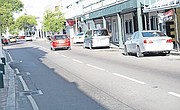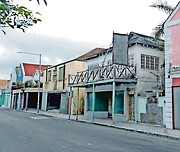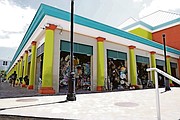Atlanta. Baltimore. Buffalo. Chicago. From Cartagena, Colombia to Seoul, South Korea, from the steel capital of Pittsburgh to the motor city of America, cities across the globe have found ways to reinvent themselves, dusting off industrial pasts and emerging as vibrant urban scenes with a future.
What did those cities, some close to utter physical decay and social and economic despair, have in common that can work for Nassau? What lessons can we learn from others while maintaining what’s distinctively ours?
First, if it’s any consolation, just about every one of those dramatic turnaround stories begins with a city down on its heels with a smattering of empty storefronts, falling rental rates and shorter business hours.
Failure begets failure, crime moves in and residents move out, seeking safer ground, abandoning once desirable downtown living quarters and a place that cannot find a way to live up to its past.
You could argue that Bay Street is not yet dead, just a patient on life support, buoyed by thousands of cruise passengers who flood the sidewalks making their way to Junkanoo Beach or the Straw Market, and caregivers like John Bull and Coin of the Realm who maintain the dream of higher standards one day paying off.
Sadly, the spirit of historic Nassau has all but vanished, sliding further south to West Hill Street, NAGB, John Watling’s, a few churches.
The trajectory is predictable - a city on its last legs and lungs attracts stakeholders who, having heard years of warning, gather and rush to the rescue of the dying patient.
In June Jacobs’ classic treatise on the life cycle of urban spaces, The Death and Life of Great American Cities, the title says it all.
Here we find ourselves, 30 years after we began talking seriously about the need for preservation and municipal management, 25 years after we commissioned the Historic Nassau Study that told us to move shipping off Bay Street, to envision the harbour as our highway and to preserve the architectural treasures we have through incentives, 20-some years after we created a tourism police division and talked about a BID (Business Investment District). Here we are, at last, with the Ministry of Tourism, Investments and Aviation taking steps to rescue the patient before it is strangled to death by an overdose of cheap t-shirt shops and cheaper souvenirs.
We kept the patient alive, breathing, but not thriving. So as we stand at this promising junction, there is much to learn from those places that were in far worse condition than Nassau, urban areas abandoned where lives were discarded along with trash, back alleys and abandoned places so economically and socially challenged that police avoided them after dark.
Nassau is in far better shape than many cities around the world that yanked themselves out of a nightmare and found the daylight.
That doesn’t mean the work will be easy or the magic happen overnight but for those of us who left a part of our heart in its architectural wonder called Nassau, its never-to-be-replicated details of leaded glass, coral rock walls, second story lofts, A-lined warehouse roofs and the arms of its madeira trees, we know a new downtown is waiting to be born.
Downtown starts with people who live there.
And here is where the story starts. It starts with people who live there.
The dream of a lively, active, bustling downtown is more than buildings whether they are set for demolition or declared the poster child of preservation. It’s the people who make a place.
To make the dream of a new historic Nassau come true, we must create a desire for people to live downtown and we can do that with something we have mastered - incentivising.
The single most basic rule of a success story in downtown revitalisation is residents in the midst of that urban space you want to bring to life. A living city means a city with people living in it.
Victoria Court, one of the last remaining architectural residential treasures downtown, needs a new roof but a new roof is expensive and so are real property taxes and other expenses. We cannot risk the loss or deterioration of this last east of East Street treasure.
There could be five-year property tax forgiveness for stores on Bay Street that convert upstairs spaces from dusty, hot storage units to contemporary lofts and apartments. Margaritaville and The Pointe are perfect examples of life breeding activity after dark – stroll down the pier in the evening between the two properties and see the action at outdoor cafes, small shops, at the marina.
But the largest potential thrust to bring life to Bay Street lies east of East Street where high-rise living can change the future of downtown Nassau from souvenir city to vibrant, pulsating capital of the nation.
To make numbers work for any developer or investor even at a mid-price point per unit, exemption to the 4-story limit will have to be granted in exchange for open green space with public able to enjoy a view of the water on either side of the structure.
Current usage of former cargo shipping properties for construction equipment storage is not only not the highest and best use of such property, it deprives the public of any view of the harbour.
Downtowns also require parks and green spaces. Every high-rise granted a building permit following all stringent environmental (DEPP) procedures must be made to donate green space downtown and a park elsewhere in a local community, including provision for upkeep and maintenance.
In heat as we have recently endured and are likely to continue to experience, we should invest in a block-wide cooling fountain.
Taxi parking spots need to be reduced in number and more staff parking must be made available south of Shirley Street with trams running downtown employees to offices, restaurants, shops and other businesses or offices. East Hill Street configuration is yet to be announced and may hold the key to double or triple-decker parking.
The Nassau Public Library should be converted to a mini-museum of pirate history once the building, which is a national treasure in danger of disintegration, is properly restored.
Re-creations of historic events should take place for photo opps throughout the historic trail along the city’s streets and side streets.
Once the new American Embassy opens, and one of the most charming streets in the country is no longer closed to the public, Queen Street should be opened up with the steps at the south end leading onto West Hill Street and providing better access to the historic district and NAGB.
Each new movement will trigger another. Residents will want more dining choices, cafes, bookstores, jazz clubs, rake ‘n scrape or an intimate entertainment venue with a single local vocalist sitting on a stool, plucking a guitar.
The boardwalk leading from east of town to the Paradise Island bridge should be wide enough for runners and leading west, for cyclists, creating more activity day and evening.
If cities from Seoul, South Korea to Pittsburgh, Pennsylvania could do it, so can we.
Nassau reborn will never be the Nassau of the past, but we have a chance to make it a Nassau we created for the future, a treasure we celebrate, not one we avoid, a proud centre of commerce for a proud people of The Bahamas.
Next week: what we need to preserve and a new look at Collins House








Comments
Use the comment form below to begin a discussion about this content.
Sign in to comment
Or login with:
OpenID